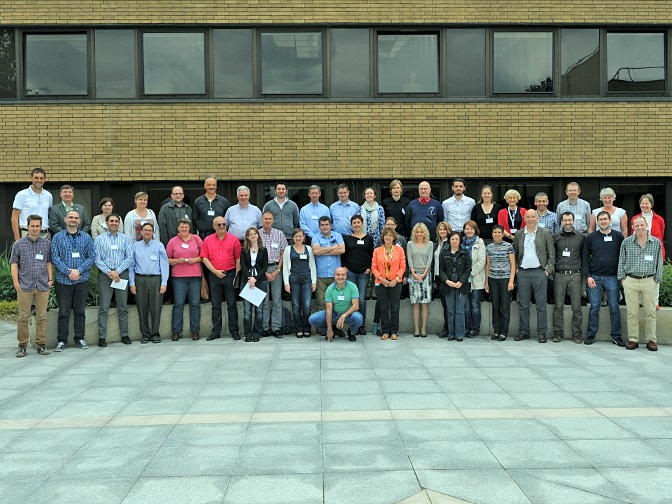

10th Eumetcal workshop
In June ECMWF hosted a workshop exploring current and future meteorological training requirements and solutions.
It attracted 70 representatives from European national meteorological services, the WMO, EUMETSAT, the UCAR COMET Program, the Australian Bureau of Meteorology, European universities and ECMWF.
As well as keynote presentations, ECMWF staff gave demonstrations on teaching satellite data assimilation and using Metview in a ‘virtual machine’ for training.
Co-organising the workshop with Eumetcal was an opportunity for ECMWF to strengthen links with the Eumetcal project. Eumetcal is the Education and Training project of EUMETNET as well as a virtual meteorological training organisation and network. Its membership overlaps significantly with that of ECMWF.
The changing role of weather forecasters
The last 20 years have seen weather predictions become more accurate, and there have been dramatic changes in the range and quality of hydrometeorological services and products available to customers and stakeholders.
“Forecasting used to be about producing a forecast from NWP models whose output was too coarse in space and time,” said Prof. David Schultz from the University of Manchester, one of the speakers at the event. “As the models have become immensely better with better resolution, forecasters are finding it harder to improve on the things the model does best. The emphasis now is on interpreting the forecast for the users and there is much more discussion about society and stakeholders.”
Education and training play a significant role in supporting staff in hydrometeorological services to gain and improve the skills needed to meet the continuously changing requirements and expectations.
The increasing use of ensemble prediction products, forecasting extreme events, and nowcasting were identified as some of the issues most likely to have a significant impact on the future provision of weather services and, consequently, on the training needs of meteorological staff.
Mapping education and training strategies and practices
Workshop participants considered different training methods, from classical classroom teaching of standard topics like mathematics, statistics and physics that underpin the understanding of atmospheric models to blended courses that combine the benefits of face-to-face sessions with the use of online resources.
Novel learning ideas and practices
There were several examples of novel ideas in delivering training. ECMWF’s OpenIFS is a powerful example of how a numerical model can be used as a laboratory for students to learn about meteorology as well as how to operate a numerical model.
UCAR/COMET demonstrated the use of the MetEd website, which brings together over 100 different courses that can be completed fully online. By leveraging improvements in technology, COMET is able to offer highly interactive online courses and study materials.
Linking national hydrometeorological services and academia
While the focus of the workshop was on the professional development of operational staff in national hydrometeorological services, the role of higher education was also considered. In many countries there is a close association between the hydrometeorological services and academic institutions, as was illustrated by the approach to academic partnerships at the UK Met Office.
This was the first year that representatives from universities joined the Eumetcal workshop, giving interesting presentations and demonstrations of approaches for teaching skills relevant in the fields of weather prediction. Of note was the presentation by Jimena Gorfinkel of the UK Open University, who described how distance learning has adapted to provide effective on-line learning.
The University of Manchester has developed a real-time weather and air-quality forecasting portal and app for teaching, which Prof. Schultz demonstrated at the workshop. “Universities should still focus on basic meteorological education grounded in mathematics and physics,” he said. “Training at operational centres should continue this education, but in a more specific context for that centre. That doesn’t mean that there shouldn’t be collaboration or cooperation, but I think each has very different training needs.”
One example of such collaboration is the University of Reading’s web-based tool for studying the physics behind extra-tropical cyclones. By extracting data on the 200 most intense North Atlantic storms from the ERA-Interim reanalysis product, the tool lets students examine an 'average' storm in the North Atlantic and look at the individual storms themselves. Horizontal and vertical slices through the storm as it grows and decays allow students to gain a deeper understanding of the physical processes at work through the storm’s life cycle.
Looking to the future
Eumetcal is currently formulating its Education and Training programme for 2016–2017. “Recommendations from the June workshop will have an impact on Eumetcal plan’s, and very likely on the emphases of other European meteorological education and training providers as well,” said Dr Tero Siili from the Finnish Meteorological Institute, who is the Eumetcal Programme Manager.
The next Eumetcal workshop is planned for 2016. “Although the specific themes of that workshop have not been decided yet, collaborations with ECMWF and academia are expected to continue and develop further in the future,” said Dr Siili.
More information
- The Eumetcal project is funded by EUMETNET (a network of European meteorological services) and EUMETSAT
- Presentations from the 10th Eumetcal workshop, 15–18 June 2015
